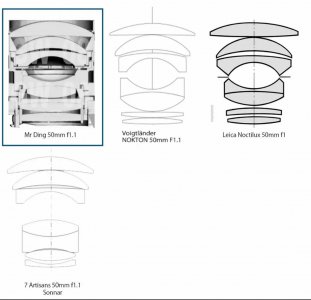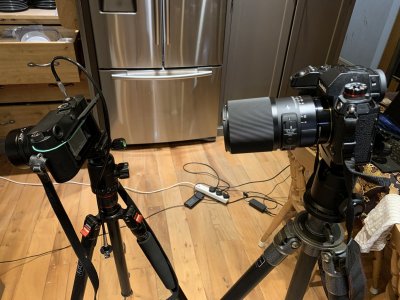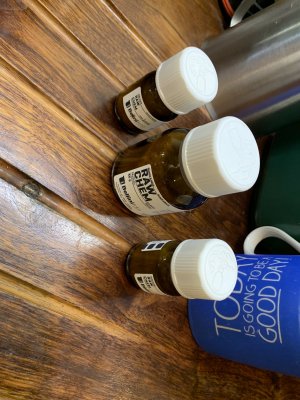santino
FSU gear head
AbsolutelyDoes the phrase "money laundering" apper in anyone else's head or only just mine?
Duofold RF
Well-known
In China, the official definition for 3 no products:
A product with questionable quality that has no expiry date, no quality certificate and no mention of manufacturer.
A product with 3 no’s (no expiry date, no authorization for production by the relevant authorities and no mention of manufacturer). 😊
Last edited:
Duofold RF
Well-known
Are we sure they put glass elements into the lens group or just plastic one? If one manufacturer can do it at this price, why LLL charge 10x?
sojournerphoto
Mentor
Does the phrase "money laundering" apper in anyone else's head or only just mine?
I did wonder about the first few entries in here
heritagecameras
Newbie
I'd post a $5 best offer, but the shipping is $36USD which I wouldn't want to pay if I "won".
I'd like to have one of these too – for novelty value if nothing else. Unfortunately shipping to the UK is even more expensive, and there's always the chance it would be intercepted and destroyed by customs officials...
sojournerphoto
Mentor
I suppose I could strip one down to check for plastic use, but I did that to the family telephone when I was 7 and finished up with a piece left over (it did still work!).Are we sure they put glass elements into the lens group or just plastic one? If one manufacturer can do it at this price, why LLL charge 10x?
More practically, why do Leica charge so much? Zeiss and these manufacturers are producing their own lens designs at much lower cost - except LLL who are producing replica copies. I’m not about to say suggest there isn’t value in Leica or assume that Chinese lenses are inherently poor or poor value. They each reflect many aspects of their production process, volume, market and volume expectations.
This lens is currently being sold for a little over half what it cost a year or so ago, presumably because it’s now been replaced with an updated and more ‘branded’ version. The new one actually has ‘almost unchanged’ optics but a new casing and, claimed, improved precision.
This is an interesting comparison of the formulae of the Mr Ding and some other similar lenses - Brian, would be interested in your comments on these?

The 7 Artisans is a Sonnar, and is very close in design to the Zunow 5cm F1.1 v2 of the mid 1950s. The Glass Filler for the middle group is made unnecessary through the use of modern coatings. The price: same that the Zunow sold for when it was new.
The Mr. Ding, Voigtlander Nokton 50/1.1, and Leica 50/1 Noctilux look like variations on the 1950s Voigtlander Ultron design, originally a 6 element in 5 group also used by Minolta in to 50/1.8 LTM lens, Leica in the v2 Rigid Summicron of the 1960s, Nikon in the 50/1.8, and others. The rear element of the Nokton and Summilux is split into two elements of lesser power, making them 7 elements in 6 groups. The Mr. Ding lens takes it one further, and splits the rear element of an Ultron into a doublet and singlet for a 1-1-1-1-2-2-1 8 element in 6 group design. These three lenses can trace their roots to the Voigtlander Ultron of the early 1950s.
The Mr. Ding, Voigtlander Nokton 50/1.1, and Leica 50/1 Noctilux look like variations on the 1950s Voigtlander Ultron design, originally a 6 element in 5 group also used by Minolta in to 50/1.8 LTM lens, Leica in the v2 Rigid Summicron of the 1960s, Nikon in the 50/1.8, and others. The rear element of the Nokton and Summilux is split into two elements of lesser power, making them 7 elements in 6 groups. The Mr. Ding lens takes it one further, and splits the rear element of an Ultron into a doublet and singlet for a 1-1-1-1-2-2-1 8 element in 6 group design. These three lenses can trace their roots to the Voigtlander Ultron of the early 1950s.
sojournerphoto
Mentor
Thanks Brian, that’s interesting.The 7 Artisans is a Sonnar, and is very close in design to the Zunow 5cm F1.1 v2 of the mid 1950s. The Glass Filler for the middle group is made unnecessary through the use of modern coatings. The price: same that the Zunow sold for when it was new.
The Mr. Ding, Voigtlander Nokton 50/1.1, and Leica 50/1 Noctilux look like variations on the 1950s Voigtlander Ultron design, originally a 6 element in 5 group also used by Minolta in to 50/1.8 LTM lens, Leica in the v2 Rigid Summicron of the 1960s, Nikon in the 50/1.8, and others. The rear element of the Nokton and Summilux is split into two elements of lesser power, making them 7 elements in 6 groups. The Mr. Ding lens takes it one further, and splits the rear element of an Ultron into a doublet and singlet for a 1-1-1-1-2-2-1 8 element in 6 group design. These three lenses can trace their roots to the Voigtlander Ultron of the early 1950s.
And for more, off topic content, I tried a new calibration rig this evening - one of the pleasures of the Chinese lens model

Ground glass on the film plane and live view on the S1r, with a suitable focus target

50g metal and 20g split phenidone
Checked one Syoptic and it was pretty good in fact, adjusted 7art 50/1.1 to remove back focus, checked C-Sonnar to confirm it’s spot on at 1.5, and struggled a bit with the 7art 75/1.25.
The 75 is very useable as is, even from 1m, but would benefit from being the focus forward about an inch. Brian, I know you have one - is the adjustment the same as for the ramped cam variants - turning the flat cam in the 75 doesn’t seem to affect focus (perhaps obviously!)
Mike
Edited to admit that I have something a bit like Raid’s ‘problem’ with 50s, although maybe not to quite the same extent
The 75/1.25: the Flat Cam (not indexed) turns in a very fine thread, so adjustment is the same. I have mine spot-on with the M9, took some doing.
sojournerphoto
Mentor
Thanks that’s great - a bit more adjustment needed to get there then.The 75/1.25: the Flat Cam (not indexed) turns in a very fine thread, so adjustment is the same. I have mine spot-on with the M9, took some doing.
xayraa33
rangefinder user and fancier
Waste of time comes to mind.
sojournerphoto
Mentor
helpful🫨Waste of time comes to mind.
Duofold RF
Well-known
The artisans' adjustable focus cam is innovation, but in other way, to compensate poor QC. If this eBay seller use the phase like Leica M prototype replica, may attract buyers to shell out $2K to own s special piece that too rare even Leica does not have it.
I appreciate the adjustable cams on these lenses, a brilliant idea- all RF lenses should have this feature.
My M9, M8, and M Monochrom- new, did not agree on focus. My 50/1.1 Nokton and 35/1.2 Nokton both required a layer of copper tape to focus properly on the M9. My M9 agrees with many others. My M240 disagreed with the M9, M8, and M Monochrom. I adjusted the M8 and M240 to agree with the M9, left the m Monochrom alone as I have a set of lenses adjusted to work with it wide-open with a Y48 and deeper filter. I adjusted the second 7art 50/1.1 to use with the M Monochrom with the Y48, and the first was perfect on the M9.
If all Leica cameras agreed with each other, calibrating lenses would be easily done. Kept me busy for years.
My M9, M8, and M Monochrom- new, did not agree on focus. My 50/1.1 Nokton and 35/1.2 Nokton both required a layer of copper tape to focus properly on the M9. My M9 agrees with many others. My M240 disagreed with the M9, M8, and M Monochrom. I adjusted the M8 and M240 to agree with the M9, left the m Monochrom alone as I have a set of lenses adjusted to work with it wide-open with a Y48 and deeper filter. I adjusted the second 7art 50/1.1 to use with the M Monochrom with the Y48, and the first was perfect on the M9.
If all Leica cameras agreed with each other, calibrating lenses would be easily done. Kept me busy for years.
boojum
Mentor
Once again, the M9 is the gold standard.
sojournerphoto
Mentor
If all Leica cameras agreed with each other, calibrating lenses would be easily done. Kept me busy for years.
The myth of Leica quality - I’ll calibrate on the black MA and then check on the M4, chrome MA and Ikon… of course, no problem with an MDa
Fortunately, I suspect film is, mostly, a bit more forgiving than digital
wrs1145
A native Texan looking for the light.
Times are getting tough in Russkie.
Share:
-
This site uses cookies to help personalise content, tailor your experience and to keep you logged in if you register.
By continuing to use this site, you are consenting to our use of cookies.

